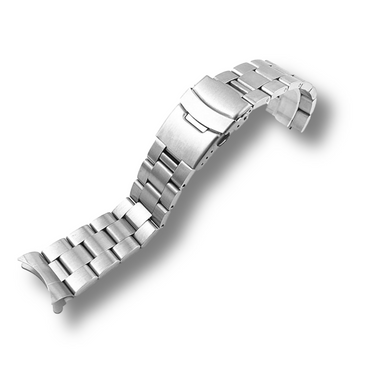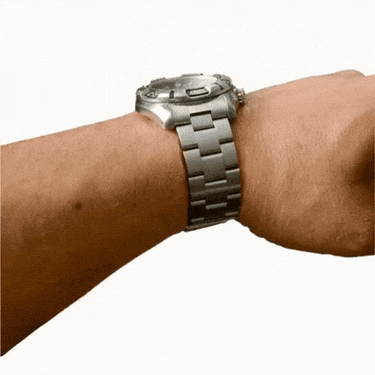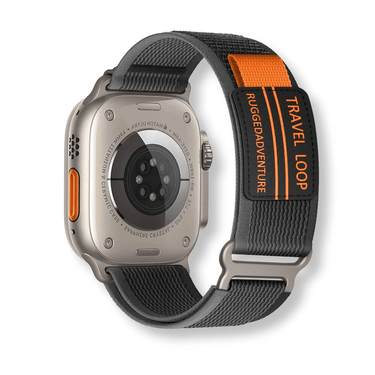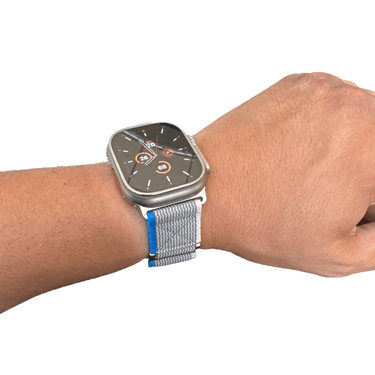The Pros and Cons of Wearing a NATO Watch Band
Wristwatches are an essential part of our daily lives, and the watch band is just as important. NATO watch bands are an increasingly popular option for watch enthusiasts who seek a durable, customizable, and affordable alternative to traditional metal or leather straps. In this article, we will explore the history and evolution of NATO watch bands and discuss their pros and cons.
Explanation of NATO Watch Bands
A NATO watch band is made up of a single piece of nylon strap that loops through the lugs or the spring bars on each side of the watch case. Unlike traditional straps that require removal from the spring bars to be replaced or adjusted, a NATO strap can be easily removed by sliding it off one end of the watch case. The design also allows you to wear your wristwatch without worrying about its falling off in case one spring bar fails.
Brief History of NATO Watch Bands
The origin story behind NATO straps dates back to World War II when soldiers needed a reliable wristwatch that could withstand harsh conditions. The British Ministry of Defence designed what was called G10 straps – named after the form soldiers used to request them - as standard issue equipment for their troops in 1973. These straps were made from nylon fabric with stainless steel hardware and were designed for ease-of-use during combat situations.
After several years, these military-style straps started making their way into civilian life through second-hand military surplus stores where some people began purchasing them as an accessory for their watches. In recent years they have gained immense popularity amongst horologists because they represent unique functionality combined with classic looks.
Purpose Of The Article
This article aims to provide readers with an overview of what a NATO strap is and how it differs from other common watch straps. It will also lay out the benefits and drawbacks of wearing a NATO strap so that readers can make an informed decision about whether it's suitable for their needs. Through this article, we hope you'll gain insight into the world of NATO watch bands, how they work, and whether they're right for you.
The Pros of Wearing a NATO Watch Band
Durability and Strength
One of the biggest advantages of wearing a NATO watch band is its durability and strength. Originally designed for military use, these straps were created to withstand rigorous activities and intense environments.
The thick nylon material used in making the straps is very strong, which means that it can withstand wear and tear better than other types of watch bands. This makes it especially popular among people who engage in outdoor activities or work in rough environments.
Versatility and Customization Options
Another advantage of wearing a NATO watch band is its versatility and customization options. These straps are available in various colors, patterns, and sizes, which means that you can easily match them with your outfit or mood.
They also come with different hardware options like stainless steel or brass buckles for added style. Additionally, you can change the strap without changing the watch itself – making it an affordable way to update your watch's look.
Comfort and Breathability
One overlooked benefit of wearing a NATO strap is its comfort level. Due to the breathable nylon material used in making them, they are perfect for warm weather conditions as they don't trap sweat under your wrist like leather straps do.Often considered more comfortable than traditional metal or leather bands due to their flexibility around the wrist.
Cost-effective Option
NATO watch bands are often considered as an affordable option compared to other types of watch bands while still being high-quality straps. This makes them ideal for individuals on a budget who still want something durable yet stylish while avoiding pricey designer accessories. Overall, wearing a NATO strap has many advantages from their durability to affordability while still looking stylish on any occasion with versatile customization options available at one's disposal
The Drawbacks of Wearing a NATO Watch Band
Limited Adjustability
One of the main drawbacks of wearing a NATO watch band is that they have limited adjustability. Unlike traditional leather or metal watch bands, NATO straps typically only come in one size.
While some brands offer longer or shorter versions, the overall length cannot be customized to fit individual wrist sizes. This can be frustrating for those with smaller or larger wrists, as the excess length may stick out awkwardly or require tucking into the loops.
Bulkiness and Thickness
Another potential downside to wearing a NATO strap is their bulkiness and thickness. Due to their multiple layers of material, they often sit higher off the wrist than other types of watch bands.
This can make them uncomfortable for some wearers, particularly those who prefer low-profile watches. Additionally, the thickness of some NATO straps can interfere with the fit of certain watches, preventing them from sitting flush against the wrist.
Limited Availability in Certain Styles or Colors
While there are many different styles and colors available for NATO watch bands, not all designs may be readily available. Some lesser-known brands may only offer a limited selection of colors or patterns, making it difficult to find exactly what you're looking for. Additionally, popular styles may sell out quickly or be back-ordered for extended periods of time.
May Not Be Suitable for Formal Occasions
One important consideration when deciding whether to wear a NATO strap is whether it's appropriate for formal occasions. Due to their casual appearance and limited adjustability options, they may not be suitable for dressier events such as weddings or black-tie affairs.
If you're unsure whether your chosen outfit warrants a more formal watch band option, it's always best to err on the side of caution and opt for something more traditional. Despite these potential drawbacks, however, many watch enthusiasts continue to rave about the benefits of wearing a NATO strap.
From their durability and versatility to their affordability and unique aesthetic, they are a popular choice for those looking for an alternative to traditional watch bands. In the end, it all comes down to personal preference and what works best for your individual needs and style.
Niche Subtopics on NATO Watch Bands
The Different Types of Materials Used in Making a NATO Strap
While nylon is the most common material used in making NATO watch straps, there are other materials available to cater for different tastes and occasions. One such material is leather, which gives the strap a more elegant look. Leather straps are perfect for formal events or daily wear.
The leather can come in various tones and textures, including smooth calf leather, crocodile skin-embossed leather, and vintage-style distressed leather. Another material used is rubber.
Rubber straps have exceptional durability and are water-resistant. They're perfect for use when swimming or diving, as they will not get damaged by water or sweat.
Rubber straps usually come in solid colors. Some watch enthusiasts opt for metal bracelets whose design mimics the NATO strap's construction style.
How to Properly Care for Your NATO Strap to Ensure Longevity
To ensure your NATO strap lasts long enough to give you your money's worth and look great on your wrist over time, it's essential to properly care for it. First, avoid exposing your band to direct sunlight or high temperatures as this can cause discoloration and warping of the material.
Secondly, wash your strap regularly with warm soapy water using a soft-bristled brush gently; this helps remove dirt and dust that can accumulate after prolonged use. If you have a leather band or a metal bracelet with perforations that tend to trap moisture underneath them after washing hands or sweating profusely during physical activity - dry off these areas carefully using a microfiber cloth before putting away the watch.
The History Behind the Different Colors Used in the Straps
NATO straps were initially issued by military organizations worldwide only in three colors- olive drab (OD), Admiralty Grey (AG), and black. In recent times, however, the color options have expanded to include a wide range of colors such as navy blue, red, orange, yellow, and even pink. The different colors are not just for aesthetic purposes; they serve a functional role in military operations.
Olive drab blends in with natural surroundings and is perfect for stealth missions. Admiralty Grey was created explicitly for the Royal Navy's use during World War Two to provide excellent visibility at night.
Red bands were used by the British SAS during their desert campaigns because it helped them blend in with the sand, while bright colors such as orange and yellow are visible from long distances making them useful in rescue missions. Nowadays watch enthusiasts have adopted this technique by matching NATO band colors with clothing or shoes.
The Appeal of Unusual Colors
While traditional NATO straps came initially in black, grey or olive green colours; there's an increasing trend towards more vibrant tones. The market has seen an explosion of new colourways recently; some of which include camo-green hues reminiscent of military-grade watches or bright neon greens that make your wrist stand out from the crowd.
These colours can be fashionable conversation starters and unique ways to express one's personal style beyond watch design itself. The great thing about NATO bands is that they're an easy way to change up your look without having to buy a new watch every time you want something different.
By understanding the different types of materials used in making NATO straps and how to maintain them properly can prolong their lifespan while still looking good on your wrist over time. The history behind each color can also add significance when choosing a strap color option that matches specific events or uses like hunting expeditions where stealth is essential or rescue missions where visibility plays a crucial role - it all depends on what you want!
Rarely Known Small Details about NATO Watch Bands
How the Name "NATO" Came About
Despite their widespread popularity, many people do not know that the term “NATO” is actually an acronym for North Atlantic Treaty Organization. The origin story of the NATO watch band can be traced back to the mid-20th century when soldiers in various countries were issued watches without standardized straps. The lack of a standardized strap made it difficult for soldiers to wear their watches in harsh environments, especially during combat.
It was only in 1973 when a British ministry of defense specification (Def Stan 66-15) was created for a nylon watch strap with one-piece construction and fixed hardware, which would later become known as the NATO watch band. The strap was designed to be durable and long-lasting, qualities that were essential for its use in military operations.
The Origin Story behind the Design
The design of NATO watch bands is simple yet effective. They are made from a single piece of durable nylon webbing with fixed hardware at each end. The original straps had three brushed stainless steel loops on them so they could be worn on watches with fixed bars.
The design was created to ensure that if one spring bar fails, there will still be another holding onto the watch case and preventing it from falling off your wrist. This feature is particularly important for military personnel who cannot afford to lose their watches during combat operations.
Why They Are Still Popular Today
One reason why NATO bands have remained popular is because they come in a variety of colors and patterns. Their versatility allows them to be worn with virtually any outfit or occasion, making them an excellent investment for anyone looking for an affordable yet stylish addition to their wardrobe.
Additionally, NATO bands are very easy to install or swap out on your favorite watch. You don’t need any special tools or expertise to do this, which makes them very user-friendly.
When you consider the low cost of NATO straps, it’s easy to see why they remain popular among watch enthusiasts. The durability of NATO bands is unmatched.
They can withstand harsh environments and daily wear and tear, making them a reliable investment for anyone looking for a long-lasting watch band. The fact that they were originally designed for military use only adds to their ruggedness and appeal.
While many people may not be familiar with the origin story behind NATO watch bands or how they got their name, their popularity remains as strong as ever today. Their simple yet effective design, versatility, ease-of-use, and durability make them a great option for anyone looking for an affordable yet stylish watch band that can stand up to whatever life throws at it.
Conclusion
After discussing the pros and cons of wearing a NATO watch band, it's clear that they have both advantages and disadvantages. The durability, versatility, comfort, and cost-effectiveness make them a popular choice among watch enthusiasts.
However, the limited adjustability, bulkiness, thickness, and lack of suitability for formal occasions can be drawbacks to some individuals. In my personal opinion, I prefer wearing NATO watch bands over other types of watch straps.
I find the customization options and durability to be particularly attractive aspects. Additionally, I appreciate the casual yet stylish look that NATO straps provide.
Despite some potential downsides, NATO watch bands remain a popular choice for many reasons. Watch enthusiasts enjoy being able to customize their timepieces with different colors or materials to match their style or outfit.
The history behind these straps also adds an element of uniqueness and nostalgia for some collectors. Overall, whether you decide to wear a NATO strap or not ultimately depends on your personal preferences and needs.
If you're looking for a durable and versatile option that won't break the bank, then a NATO strap might be worth trying out. As with everything in life there are always trade-offs but in my view at least with the NATO Watch Band you get much more than its limitations!

























